Bonny Light Bears Inhumanity
JC Bright
February 2022
One Sunday morning, Abacha kill Saro-Wiwa
One Sunday morrrrrrrrrrrrrrrrrning, Abacha kill Ssaaroo-Wiiiwa.
This essay was inspired by a conversation with an acquaintance, Kasala, with whom I share a street. Kasala’s hometown is Ogoni, in the Niger Delta – a region that rose to international attention after a massive public protest campaign against Royal Dutch Shell, which led to the public execution of environmental activist Ken Saro-Wiwa and eight others. This extreme reaction by the Nigerian government marked the beginning of, as environmental sociologist Al Gedicks puts it, “an inseparable connection between the assault on the environment and the assault on human rights” in the Niger Delta as elsewhere.1 But in the case of the Niger Delta, this struggle relates to the scramble for “Bonny Light,” the highest grade of crude oil found only in that region and an important benchmark of West African crude production.2 In Kasala’s words, Saro-Wiwa na our god.
One Sunday morning, Abacha kill Saro-Wiwa
One Sunday morrrrrrrrrrrrrrrrrning, Abacha kill Ssaaroo-Wiiiwa.
During our conversation, I recalled this two-line song we sang as children in the city of Port Harcourt. Back then, we didn’t know if it had any more words. We simply sang it, ignorant of the significant subtext most of us would find out about when we came of age. It was only later I discovered it was a straightforward tale of how General Sani Abacha, who was Head of State at that time, killed Ken Saro-Wiwa and eight others, all of Ogoni origin, for standing in the way of the Royal Dutch Shell oil company. As I learned the reality beneath my childhood song, I came to understand that ecocide, which Saro-Wiwa died fighting, is a cause of Niger Delta-wide suffering. I became aware of the dangers of the orange flame that reared above our apartment in Elelenwo, flared gas from the Oil & Gas Free Trade Zone in Eleme-Onne (next to Ogoni) – and just how much of our knowledge of Saro-Wiwa’s legacy has been passed down through songs, poems, films, and visual art.
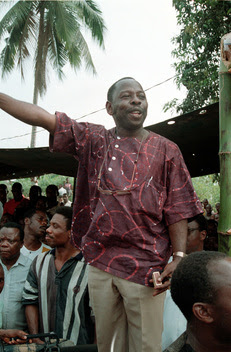
Ken Saro-Wiwa speaking at an Ogoni Day demonstration in the Bori Region, Nigeria, January 5, 1993. The demonstration was officially called to mark the start of UNICEF’s International Year of Indigenous People, but unofficially it was organized against Shell oil company. Photo: Tim Lambon/Greenpeace.
On October 31, 1995, a year after I was born, General Sani Abacha ordered the execution of the infamous Ogoni Nine3 – Ken Saro-Wiwa, Barinem Kiobel, John Kpunien, Baribor Bera, Saturday Dobee, Felix Nwate, Nordu Eawo, Paul Levura, and Daniel Gbokoo – by hanging. Contrary to Saro-Wiwa’s rising and momentous environmental activism, the government’s justification hinged on a trumped-up murder charge to get rid of him and the eight others. The plot was catalyzed by a case of four mobbed Ogoni elders whom the perpetrators believed were pro-Shell as well as pro-government.4 At the time, Shell was the only crude oil exploration company operating in Ogoni, and as such, was responsible for all oil-related environmental damage within the area.5 For money in the pocket, the Nigerian ruling class found Shell too hot to penalize.
While best known for his accomplishments as an activist, Saro-Wiwa had already gained wide acclaim for his writing prowess prior to his activist strides. Some of his works include the anti-war novel Sozaboy: A Novel in Rotten English (1985),6 the sitcom Basi and Company,7 which aired on Nigerian national television, and the collection of newspaper columns later published as Genocide in Nigeria: The Ogoni Tragedy (1992).8 For a time, Saro-Wiwa even worked for the Nigerian government and made an appearance at the 1992 Earth Summit in Rio de Janeiro, Brazil, in which he spoke under the provision made for nongovernmental organizations (NGOs) to underline the impact of human socio-economic activities on the environment in the Niger Delta. Yet, only three years later, on November 10, 1995, the Ogoni Nine were hanged.
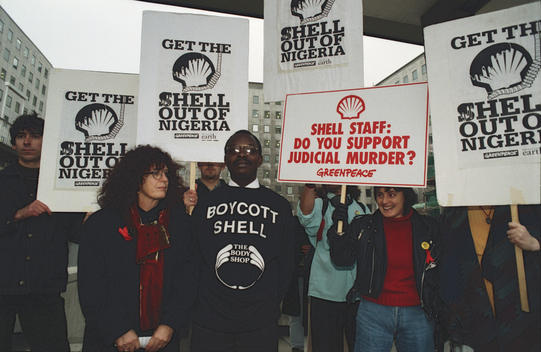
Protest outside Shell International HQ in London following the execution of Ogoni leader Ken Saro-Wiwa. Dr. Owens Wiwa (Ken’s brother) and Anita Roddick (The Body Shop) spoke at the demo, December 1, 1995. Photo: Greenpeace/John Novick.
Nigeria Jaga Jaga
Everything scatter scatter
Poor man dey suffer suffer
Gbosa, gbosa, gunshot inna the air
—Eedris Abdulkareem, “Nigeria Jaga Jaga” (2002)
Seven years later, the musical hit by Eedris Abdulkareem, “Nigeria Jaga Jaga,” (2002), was banned by the Olusegun Obasanjo-led government. The song is about the battered Nigerian system, which has, according to the Nigerian hip-hop artist, left the country in shambles. The song remains relevant twenty years after its release. Our overdependence on oil has transformed the Niger Delta into a zone the government is willing to commit atrocities to exploit. The global reaction against the execution of the Ogoni Nine did not bring about change in the Niger Delta; the evils of exploitation ensue to this day. While the oil companies clamp down on dissent and any form of intervention that disrupts oil extraction in the region, one cannot deny that government entities that prefer to silence a dissident countryman rather than lose an environmentally toxic relationship with a Western establishment are also largely to blame for these issues.

Eedris Abdulkareem interviewed on Channels TV’s Rubbin’ MINDS about “Nigeria Jaga Jaga” (as well as “Mr. Lecturer” on sexual harassment in academia) 18 years after its release, January 12, 2020.
In 2011, the United Nations Environment Programme (UNEP) published a report on its independent scientific assessment of the area. The report showed that pollution from over fifty years of irresponsible oil extraction had caused greater damage than what could be seen only on the surface. According to the UNEP, the degree of environmental remediation needed to restore everything damaged would, in their words, “prove to be the world’s most wide-ranging and long term oil clean-up exercise ever undertaken if contaminated drinking water, land, creeks and important ecosystems such as mangroves are to be brought back to full, productive health.”9
You would think the Nigerian government, who initiated the invitation for the assessment, would be moved to initiate change after the results were published, but it was not until 2017 that the Ogoniland Cleanup Project was launched. The Niger Delta Development Commission (NDDC) established in 2000 has proven to be a tool for political compensations and favors via the award of contracts. Most recently, the current Minister for Niger Delta Affairs, Godswill Obot Akpabio, implied another one of the impunities the commission has been reduced to. According to the Former Senator/Akwa Ibom State Governor (who appears to be trying to save his head in the heat of an investigation), individuals take up top positions in the NDDC to raise election campaign funds. As expected, this controversial investigation revealed cases of embezzlement, but no convictions have been made to date. More recently, Shell was directed to pay the Ejama-Ebubu community in Eleme Local Government Area of Rivers State N49.5 billion (111 million USD).10 However, compensation on this scale in the ecocide conservation of the Niger Delta will never make up for even the tiniest bit of damage on the area’s topography. In 2022, Ogoni Indigenes still fish in oily waters.
Since Saro-Wiwa’s death, I gained additional interest in others who continue to speak about issues of the Niger Delta. Perhaps his work acted as a catalyst for some, if not all, who came afterwards. An anthology titled For Ken, for Nigeria, compiled by the Nigerian writer E. C. Osondu the year after the Ogoni Nine hanging, responds directly to the tragedy as well as issues surrounding it. The anthology covers subject matters relating to Saro-Wiwa, the rights of minorities, and the environment. Contributing poets included Nnimmo Bassey, M. S. C. Okolo, Chinua Ezenwa-Ohaeto, Ademola Babajide, and Medus Deekor. Later in 2010, Nnimmo Bassey, who chaired Friends of the Earth International (one of the largest environmental organizations in the world) from 2008 through 2012, was awarded The Right Livelihood Award, “for revealing the full ecological and human horrors of oil production and for his inspired work to strengthen the environmental movement in Nigeria and globally.”11
Contrary to that particular focus on Saro-Wiwa’s activist life, Toyin Falola and Roy Doron chose to write about everything in their biography Ken Saro-Wiwa,12 including the era leading up to his activism.13 Their biography helps us see what might have happened if there had not been a fall out between Saro-Wiwa and the Nigerian authorities. This aspect of their book reflects on the oldest disease to have stricken Nigeria’s progress: the practice of enriching oneself with public funds or positions. In the book, Saro-Wiwa is accused of using public funds to finance private businesses and pay for private trips abroad. In analyzing Saro-Wiwa’s pre-activist allegiance to the Nigerian government, Falola and Doron suggest his dining with the Nigerian government was premeditated on his ability to discern who would win the Biafran War. When the Nigerians captured the oil-rich Bonny Island at the outset of the war, Saro-Wiwa found a way to become the government civilian administrator of the area. The authors spur me to think Saro-Wiwa may have remained with the Nigerian government if things had happened differently.
Additionally, there are two films worthy of mention. The first, Jesse: The Funeral That Never Ended (2019), evokes the presence of Saro-Wiwa through his daughter, Singto, who narrates this directorial debut of the Niger-Delta-born journalist Eromo Egbejule. The film revolves around the 1998 pipeline explosion that occurred in Jesse, Delta State under the Nigerian National Petroleum Commission. This rupture caused over a thousand deaths and was considered the worst petroleum explosion to ever hit Nigeria. Apart from the film’s documentary role, the function of Singto Saro-Wiwa – twenty-four years later, in the exact terrain that rendered her fatherless – is a symbolic feat that says: The land is still a curse to the people that inhabit it.
The second film, Blood and Oil by British screenwriter Guy Hibbert, addresses human rights abuse and other dirty antics of the Nigerian oil sector. In 2010, it hit BBC screens to tell the story of two women investigating the circumstances behind the death of four hostage oil workers and their militant captors. The film reflects a heated period in the history of the Niger Delta agitations, an era when kidnapping, militancy, ransom, and pipeline bombing were normal occurrences. Restive youths of the Niger Delta decided to fight back with terror, bringing stakeholders in the oil sector to their knees. At that time, former militant leaders Asari Dokubo (born Melford Dokubo Goodhead Jr.), Government Oweizide Ekpemupolo alias Tompolo (during most of the present government’s regime, Tompolo has lived in hiding; he is not in good rapport with the Buhari-led government), and Ateke Tom were at the forefront of disrupting oil extraction through inter-group conflicts and obstruction. Other militia controllers included Soboma George, gunned down in 2010 with myriad stories of who killed him and why, and Ebikabowei Victor-Ben, also known as General Boyloaf. Terror became the only language that registered in the ears of the Nigerian government. A flash of attention called “amnesty” was employed by the government led by Umaru Musa Yar’Adua to broker peace with the angry youths. Added to it was the promise to pump in rapid infrastructural development – but, from all indications, no tangible change has occurred. Blood and Oil depicted the triangle of members – the government, corrupt Niger Delta Indigenes, and the oil companies – behind lack of progress in tackling issues in the Niger Delta explicitly.
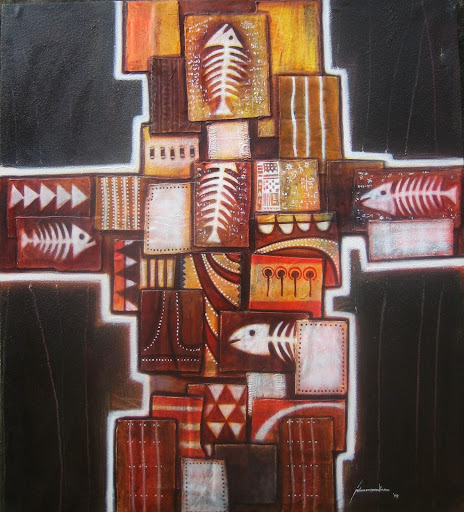
Johnson Uwadinma, No Fish (I). Courtesy of the artist.
In terms of the contributions of visual artists addressing the Niger Delta in their artistic repertoires, these include Kainebi Osahenye, Ayo Akinwande, Segun Aiyesan, Chris Aghana Nwobu, Akintunde Akinyele, Timipre Willis Amah, George Osodi, Otobong Nkanga, Sokari Douglas Camp, Victor Ehikhamenor, Johnson Uwadinma, Abraham Oghobase, and another Saro-Wiwa daughter, Zina. In Karikpo Pipeline (2015), Zina Saro-Wiwa employs the performative, land, and the vegetal in granting audiences an alternate reality of the Niger Delta. The five-channel video installation recruits icons of the usual disaster narrative as a backdrop to suggest a probe into the Niger Delta beyond the former. Juxtaposing the Ogoni geography (a metaphor for ecocide) with its cultural patrimony, the work references Karikpo, a recreational performance mask peculiar to the Ogoni people. With this pairing, Zina Saro-Wiwa raises conversations around the abusive relation between the resource/cultural abundance of Ogoniland and its oil. The work serves as a catalyst to drive imaginations around the featured landscape, comparing the present to the time before oil, underlining fortunate entities who escaped the massacre of ecocide, and exploring what can be seen or achieved through the survivors.

Victor Ehikhamenor. The Wealth of Nations, 2015. Source: victorehi.com.
Victor Ehikhamenor’s work is momentous. His ephemeral two-part installation The Wealth of Nations (2015) formed part of the 2015 Jogja Biennale. The indoor aspect of the installation grew to be the most popular, perhaps an achievement caused by its intense visual appeal. First, the installation hits the viewer with the feeling of being housed in a sanctuary. Apart from the opening of a tub from which an illuminated liquid is viewed, everything that makes up the room is clothed with Ehikhamenor’s insignia: lines woven into a pattern of all-over painting. Three drums extend from the room’s ceiling to take positions above the tub. The drum in the middle drips black liquid into the tub’s red liquid, but what is most significant is the inscription beneath the water – Oloibiri – the first site of Nigeria’s commercial crude oil extraction. In response to the drastic fall in the value of crude oil due to Covid-19, the artist recently took to Instagram to spell out what he wanted to achieve with the work:
View this post on Instagram
It is easy to get carried away by the work’s opulent physicalities. Hence, I do not think the piece adequately communicates its activist message. For a work of activist art to be effective, it must, to some degree, convey an instantaneously graspable message, one whose meaning relies on neither the artist’s biography nor extratextual evidence. Nonetheless, it emboldens the inconsequentiality of Oloibiri and the fact that despite being the pioneer drill site for crude oil in Nigeria, it is stricken by severe poverty. The Wealth of Nations draws attention to this disenfranchisement and its relationship to ecocide in the Niger Delta.
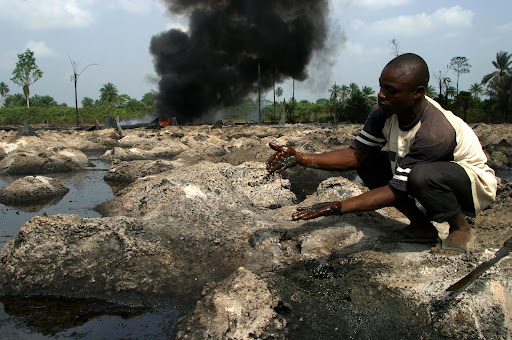
George Osodi. Oil Spill Over Farmland, 2004. Courtesy of the artist.
Examples of works that deliver a pellucid argument include George Osodi’s photography book Delta Nigeria: The Rape of Paradise (2011) and Sokari Douglas Camp’s sculpture Battle Box (2005). They achieve clarity without having their intentions surface in a pedestrian manner. You can connect to the works with all of your senses, and the effect communicated in precise language contributes to their success. For me, clarity is the most suitable approach for issues as crucial as environmental damage and neglect in the Niger Delta – crimes that continue to be downplayed by their perpetrators and complicits.

George Osodi. Gas Flare Utorogun, 2005. Courtesy of the artist.
Photographs in Osodi’s book Delta Nigeria prompt the question: What devil possessed you to go with your camera into the Niger Delta, known for causing trouble even in less charged places? One time the artist was kidnapped by restive youths of the region; he was released after he swore that he did not work for the government or any entity that posed a threat. Courageously, Osodi kept going back. His dedication to capturing risky terrain grew into Delta Nigeria, his first and only photobook to date. Osodi’s statement has reached local, continental, and international audiences. His work has been shown at widely attended exhibitions such as the Venice Biennale and documenta.
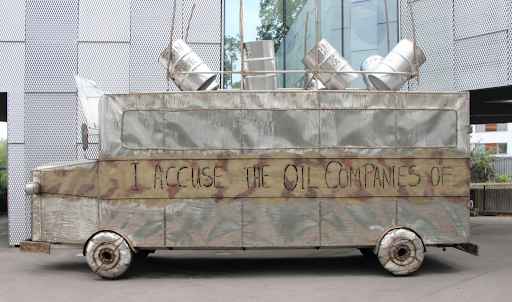
Sokari Douglas Camp. Battle Box, 2005. Source: priceofoil.org.
To return to Sokari Douglas Camp’s role in the Niger Delta struggle, it is important to highlight her sculpture Battle Bus (2005), a monument to Saro-Wiwa. Having traveled the United Kingdom for nine years at the request of the Ogoni Solidarity Forum and other civil society groups, the life-size stainless steel bus was sent to Nigeria as a gift to the Ogoni people. On landing in Nigeria in 2015, Battle Bus was impounded by the government on account of its alleged political implications. They claimed it possessed the ability to cause unrest in the country. Indeed, running along three sides of the bus was the bold statement: I accuse the oil companies of practising genocide in Ogoni. Also inscribed on the bus were the names of the Ogoni Nine. For the artist, oil in the Niger Delta and ecocide by oil exploration were overdue subject matters. Perhaps her affiliation with the organization behind Battle Bus, Platform London, is the reason: they triumphed in branding BP and Shell the oil industry’s bad boys. The organization continues to highlight ecocide practices and the role of museums in laundering these dirty dogs via cultural sponsorships. They also coordinate the collective Oil Sponsorship Free, which refuses to advertise fossil fuel companies in arts and culture. Hence, environmental damage by oil companies is a global game, but the Niger Delta cases are carried out with no fear of prosecution.
Artworks alluding to the Niger Delta record the region’s suffering. Each time a work addressing this topic surfaces, it reflects the absence of significant change from the time when Saro-Wiwa was hanged. It reveals, once again, that the Nigerian government of the present is not any different from the Nigerian government of the past towards individuals who confront it. In this way, Saro-Wiwa’s legacy is even more important today, given the swathe disregard for human life and the environment in the Niger Delta, especially considering there is now an increasing rate of people-driven damages. In Port Harcourt, where the rate of illegal oil refining is on the rise, the black soot is life-threatening in the way it has captured a tangible amount of the cityscape. These present difficulties serve to remind us why Saro-Wiwa forms an irreplaceable part of environmental activism in the Niger Delta. He took on the government entities that could bring an end to his people’s sufferings but were selfishly turning a blind eye – and he did so by announcing the atrocities on the world stage.
Footnotes
- Al Gedicks, Resource Rebels: Native Challenges to Mining and Oil Corporations (Cambridge, MA: South End Press, 2001), 41. For further information see Basil Sunday Nnamdi, Obari Gomba, and Frank Ugiomoh, “Environmental Challenges and Eco-Aesthetics in Nigeria’s Niger Delta,” Third Text 27 no. 1 (2013): 65–75.
- “Bonny Light crude,” Refinery Reference Desk, McKinsey & Company, accessed February 14, 2022.
- Saro-Wiwa became the second significant Niger Delta agitator to be quelled by the Nigerian government. Before him was the twelve-day Niger Delta Republic of Isaac Adaka Boro. Unlike Saro-Wiwa’s Movement for the Survival of Ogoni People, Boro’s Niger Delta People’s Volunteer Force declared a secession. Boro would later fight to defeat the Biafran secession after a presidential pardon from General Yakubu Gowon.
- Basil Sunday Nnamdi, Obari Gomba & Frank Ugiomoh, “Environmental Challenges and Eco-Aesthetics in Nigeria’s Niger Delta,” Third Text 27:1 (2013), 65-75, 10.1080/09528822.2013.753194.
- I feel obligated to add that when spilled oil and flared gas began to cause damage in Ogoni and other parts of the Niger Delta, I am convinced the region exclaimed excruciatingly in response to the second form of painful extraction it was pierced with. The Benin Expedition and other forms of British rape between 1895 and 1901 (during which valued objects were stolen) were followed by a religiously induced iconoclasm between 1915 and 1918. It is safe to say that the Niger Delta is a site of both cultural and environmental molestations.
- Ken Saro Wiwa, Sozaboy: A Novel in Rotten English (Port Harcourt: Saros International, 1985).
- “Basi and Company,” Wikipedia, last modified February 12, 2022.
- Ken Saro-Wiwa, Genocide in Nigeria: The Ogoni Tragedy (Nigeria: Saros International Publishers, 1992).
- “UNEP Ogoniland Oil Assessment Reveals Extent of Environmental Contamination and Threats to Human Health,” UNEP, August 7, 2017.
- William Clowes, “Shell Will Pay $111 Million to End Nigerian Oil-Spill Case,” Bloomberg, August 11, 2021.
- “Right Livelihood Award Foundation releases new documentary about Nnimmo Bassey,” Right Livelihood, August 15, 2014.
- Roy Doron and Toyin Falola, Ken Saro-Wiwa (Athens, OH: Ohio University Press, 2016).
- Portia Roelofs, “The Nigerian Activist Whose Death Shamed Shell: Interview with Roy Doron and Toyin Falola,” Jacobin, October 11, 2019, www.jacobinmag.com/2019/11/ken-saro-wiwa-nigeria-environment-oil-companies-ogoni.
JC Bright (b. 1994) is an artist, art historian, writer, and curator. Chiefly driven by momentary fascinations, his work unpacks layers of experiences with the self and shared spaces, alongside a bias for familial encasements. Recruiting abstraction and botanical manifestations in the biomorphic, he unweaves intricacies, personal and other opinions as a means of constructively probing layers of his investigations. Currently, he is researching abstract art of Africa and the African diaspora, while his curatorial work is based around agency, eco-aesthetics, and materiality. He is the Associate Curator for Rele Gallery in Los Angeles and Lagos. Bright earned a First Class Bachelor's in Fine Arts and Design from the University of Port Harcourt, specializing in Art History. He lives and works in Lagos, Nigeria.